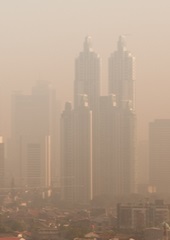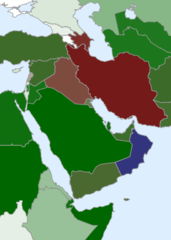Haze: Asia’s New Weapon
In Southeast Asia and beyond, it’s high time to rethink the meaning of security.
September 8, 2013

Haze may be the new weapon of mass destruction. Not in the narrow sense of an incoming ballistic missile, of course, but for millions in Southeast Asia, this summer’s sooty haze poses a threat more dire than a nuclear-tipped missile.
In mid-June, particulate-filled smoke from burning forests and peat on the Indonesian island of Sumatra moved east to envelope Singapore and parts of Malaysia.
At one point in late June, Singapore’s Pollutant Standards Index soared to 401. Any reading above 100 is considered unsafe to breathe. Air pollution of this magnitude represents a serious health hazard, vastly increasing the risks of respiratory infections, skin and eye irritation, as well as cardiovascular problems.
Businesses in the affected areas shut down. Schools closed. People stayed indoors. The costs to Indonesia, Singapore and Malaysia in increased health expenses, lowered productivity, absenteeism and reduced consumer activity will total in the tens of millions of dollars. The consequences for the health of the region’s inhabitants will be far higher.
The haze also triggered diplomatic tensions in the region. Singapore lodged complaints, then more pointed protests. Malaysia called for an emergency meeting of the Association of Southeast Asian Nations (ASEAN).
Amidst growing regional anger, Indonesian President Susilo Bambang Yudhoyono issued a public apology. That, in turn, triggered venomous indignation from Indonesian nationalists. They complained that a unilateral apology was submissive and dragged down national honor.
Local causes, regional consequences
Many of the fires responsible for the haze, the president’s critics asserted, were deliberately set by companies based in the very countries now loudest in their complaints.
The cause of the haze is no mystery: Wholesale slash-and-burn practices to clear forests for farming and other commercial purposes. These land-clearing techniques are cheap and efficient and therefore widespread. But they are also illegal.
Those responsible for the fires include small farmers, logging companies, and large palm oil and pulpwood corporations. Their actions were abetted by unusually dry weather, official corruption and indifference.
This is not the first time that Southeast Asia has experienced haze and smoke generated from fires in Indonesia. In 1997, a similar phenomenon roiled the region. It exposed an estimated 100 million people to acute health risks — and led to thousands of premature deaths due to haze-induced medical problems.
Old notions of national autonomy and state sovereignty seem oddly quaint when fires deliberately set in one country can adversely impact the people of neighboring countries.
Nor is haze the only worry. In the interconnected world of the 21st century, national borders are irrelevant in the face of threats as varied as international terrorism, food safety, the security and sustainability of clean water supplies, new strains of infectious disease, cyber vandalism, and large-scale migration.
Over the past several decades, Southeast Asia has begun to erect a multinational institutional framework. Under the right conditions, it might play an important role in combating transnational threats of this nature.
But much more needs to be done. Absent a consensus that still eludes the region, ASEAN remains ill equipped to persuade member governments to take steps that could alienate important domestic constituencies.
Fighting transnational threats
Combating transnational threats of this nature will require new ways of thinking about the trade-offs between jobs and the environment, between individual and collective rights and responsibilities, and between short-term profits and long-term sustainability.
It will require government bureaucracies, many having institutional and budgetary reasons to resist change, to abandon established routines.
It will require a serious marshaling of resources, at both official and non-official levels — including that most scarce of all resources, the attention of senior decision makers.
It will require new frameworks of cooperation in at least three separate dimensions — within governments, between governments, and between governments and the private sector.
It will require region-wide adherence to existing agreements (such as the 2002 ASEAN accord on transboundary haze pollution) and the negotiation of additional pacts providing for greater cooperation and more rigorous enforcement.
Decentralization — frequently applauded as a way to give people a greater voice in governance — can be a liability in combating problems that overlap governmental jurisdictions, such as this year’s haze.
Until state oversight capacity is enhanced, Indonesia will almost certainly fail in surmounting its haze challenges even when the political will exists.
Yet top-down responses are seldom sufficient for dealing with a threat of this nature. Unless there is buy-in from local private and official players, national and international corporations, workers, community organizations and other impacted actors, directives from Jakarta are not likely to be effective.
For purely self-interested reasons, the more advanced economies of the region should also contribute to fighting the haze problem. They can do so by supporting existing programs and providing financial incentives for responsible land management practices.
The worst of the region’s haze crisis has abated — for the moment. But since forest fires generally peak during the months between August and October, Southeast Asia may not have escaped this year’s haze crisis yet.
Moreover, the higher temperatures associated with global warming will almost surely guarantee that haze will return in future years.
Southeast Asia’s smoky skies underscore a larger truth: National security and safeguarding a country’s population are no longer matters to be left primarily to diplomats and generals.
Successfully managing Southeast Asia’s haze crisis will require new ways of thinking about security. Nearly every country in the region is upping its arms spending. But not all threats can be deflected by bullets and bombs.
Takeaways
Haze may be the new weapon of mass destruction for millions of people in Southeast Asia.
National security is no longer a matter to be left to diplomats and generals.
Southeast Asia may not have escaped this year's haze crisis yet.
Decentralization, often a way to give people a voice in governance, can be a liability in transboundary issues.
ASEAN is ill equipped to persuade member states to take steps that could alienate key domestic constituencies.

